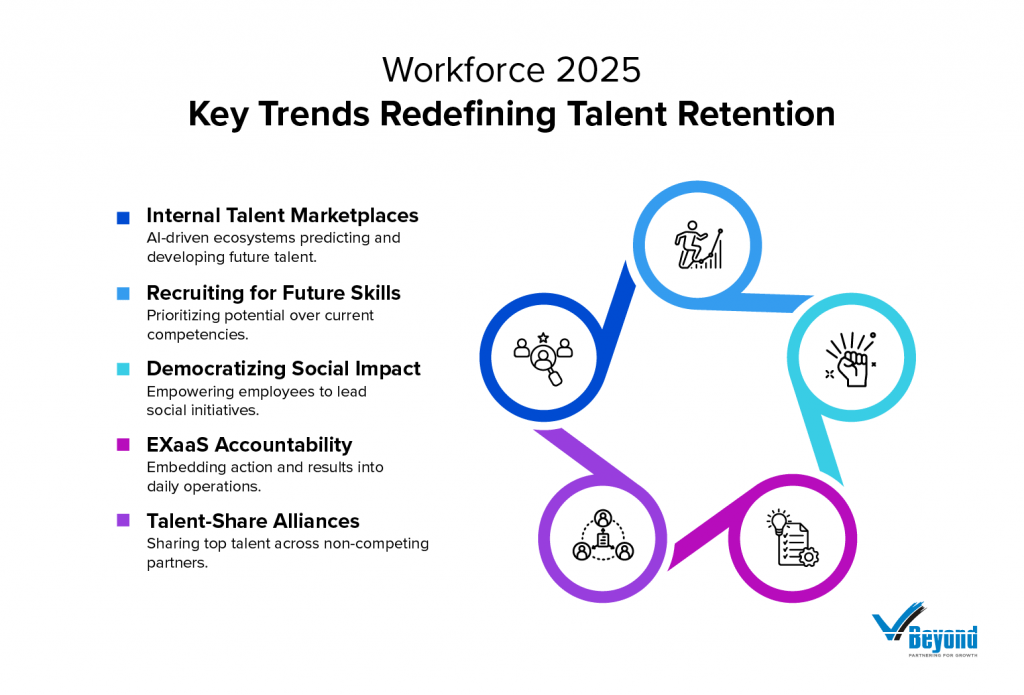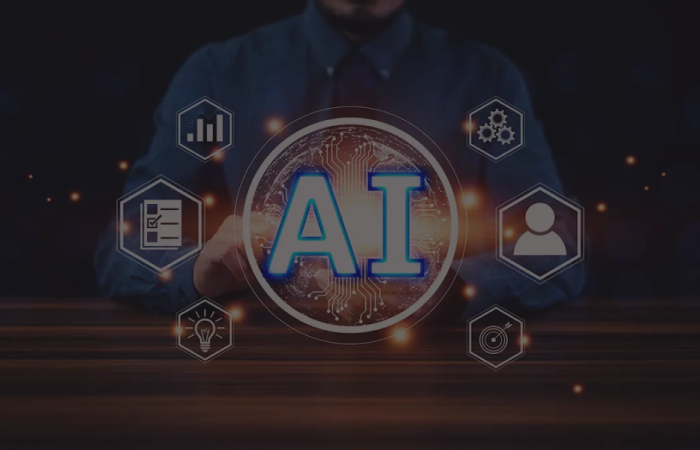As we approach 2025, the traditional playbook for employee retention strategies is being rewritten. Companies are embracing innovative workforce retention strategies that prioritize strategic workforce planning, employee engagement analytics, and organizational agility. The shift is not just a response to the evolving demands of the workforce but a proactive approach to shaping future workplace trends.
In this blog, we will explore five trends likely to shape workforce retention in 2025.
Navigating the New Era of Talent Management
With 2025 inching closer, the workforce is experiencing seismic shifts driven by changing generational values, rapid technological advancements, and an increasing emphasis on human sustainability. Deloitte’s 2024 Gen Z and Millennial Survey highlights that these generations consider purpose as a pivotal factor in their job satisfaction. Many Gen Z and millennials are increasingly rejecting the paycheck for meaningful engagement with their work and employers who reflect their ethical and social concerns.
Simultaneously, the Future of Work Report 2024 emphasizes the transformative role of artificial intelligence (AI) in reshaping the employment landscape. AI’s integration into the talent value chain, now leveraged by over 90% of leading service providers, is not only optimizing efficiency but also fundamentally altering job roles, workflows, and the skills required for the future. As AI continues to advance, it’s becoming clear that the future workforce will need to adapt to roles that are increasingly collaborative with AI technologies, requiring new skill sets that are yet to fully emerge. This presents both a challenge and an opportunity for organizations to stay ahead by fostering a culture of continuous learning and innovation.
Further expanding on these insights, the 2024 Global Human Capital Trends report introduces the concept of a “boundaryless” future, where traditional organizational constructs are being reimagined to prioritize human performance over mere productivity. In this new paradigm, businesses are moving away from conventional metrics and embracing more holistic measures of human performance that encompass well-being, creativity, and adaptability. The report also highlights the rise of “microcultures” within organizations, where diverse teams are empowered to develop their own cultural identities while staying aligned with the broader organizational values. This approach not only enhances employee engagement but also drives innovation by allowing for greater flexibility and personalization in how teams operate.
These forces are reshaping how businesses attract, engage, and retain talent, making it crucial for leaders to stay ahead of emerging trends. The following sections will delve into key trends likely to influence workforce retention and management in 2025. By understanding and implementing these trends, organizations can position themselves as leaders in the workforce of 2025, creating environments where employees not only stay but thrive.
Key Trends Redefining Employee Retention Strategies and Shaping the Workforce of 2025
Here are five trends, pivoting on talent management and empowerment, that are likely to redefine workforce retention strategies and influence how organizations manage their most valuable asset—their people.
1. Organizations as Internal Talent Marketplaces
Trend Overview: By 2025, the internal talent marketplace is expected to evolve from a simple job-matching tool into a sophisticated, AI-driven ecosystem that seamlessly integrates with broader organizational strategies and individual career aspirations. These advanced marketplaces will no longer merely respond to current needs—they will proactively predict future talent demands, cultivate necessary skills within the workforce, and dynamically adjust to ongoing business changes in real-time.
Employees will increasingly view their careers as fluid journeys, filled with constant opportunities to pivot, upskill, and embrace new challenges within the organization. The internal talent marketplace of the future will be a dynamic, adaptive entity, continuously evolving alongside both the organization and the external environment.
Action Steps/Strategies:
- AI-Powered Skill Evolution Platforms: Organizations should advance their internal talent marketplaces by developing AI-driven platforms that not only match employees to current roles but also track the evolution of skills in real-time. These platforms could analyze market trends, industry disruptions, and employee learning patterns to recommend precise skill development paths and future role transitions. By continuously updating skill requirements and suggesting tailored learning modules, these systems will ensure that employees remain ahead of the curve, prepared for emerging opportunities within the organization.
- Talent Tokenization and Micro-Credentials: Moving beyond traditional certificates, organizations can tokenize skills and achievements into micro-credentials stored on a blockchain. Each project completed, skill acquired, or training undertaken would be tokenized, creating a verifiable digital ledger of an employee’s career progression. This system would allow employees to showcase a granular level of expertise within the internal marketplace, making it easier for managers to identify the right talent for specific projects and for employees to navigate diverse career paths with recognized credentials.
- Dynamic Talent Clouds for Agile Teams: To further enhance internal mobility, companies can create dynamic talent clouds—flexible, project-based teams that are assembled and disbanded as needed. These clouds would pull from a pool of internal talent based on real-time project needs and employee skills. By encouraging employees to participate in multiple talent clouds simultaneously, organizations can foster a more agile workforce capable of rapidly responding to new business challenges. This model promotes continuous learning and innovation, as employees constantly engage with different teams and projects, gaining a wide array of experiences and skills.
These strategies push the concept of internal talent marketplaces beyond the current practices, emphasizing the need for organizations to continually innovate and adapt. They offer unique approaches that can help companies transform their talent management systems into dynamic, future-ready ecosystems.
2. Recruiting Beyond Today’s Skills
Trend Overview: The AI revolution is fundamentally altering the landscape of work. The demand for new, undefined skills is accelerating, and traditional recruitment models are struggling to keep pace. According to an article on HR Grapevine, a digital resource for HR professionals, there is need for organizations to shift their focus from merely hiring for current competencies to identifying human potential and inherent capabilities. This is essential for creating a workforce that can adapt and thrive in roles that are still emerging or yet to be defined.
Action Steps/Strategies:
- Adopt a “Potential-Centric” Recruitment Model: Move beyond traditional skill-based hiring and fully embrace a potential-centric recruitment model. This approach prioritizes inherent traits such as complex problem-solving, analytical thinking, and creativity—qualities that are critical for future AI-driven roles. Organizations could use more advanced psychometric assessments and AI-powered analytics to identify candidates who demonstrate these core competencies, even if they lack specific technical skills. This shift in focus from “what candidates know” to “how candidates think and learn” will be essential in preparing for future skill needs.
- Develop a “Human Potential Index” for Talent Evaluation: Create a “Human Potential Index” (HPI) within your recruitment process—a dynamic metric that evaluates a candidate’s potential to learn, adapt, and innovate based on a combination of psychometric testing, AI-driven insights, and real-time scenario-based evaluations. This index would become a key factor in hiring decisions, enabling organizations to predict which candidates have the highest potential to develop the skills that will be critical in the future. By continually refining the HPI with data from employees’ on-the-job performance and learning progress, organizations can ensure that their talent pool remains resilient and adaptable.
- Build a “Futures-Ready” Talent Incubator: Establish a talent incubator within the organization specifically designed to nurture potential in individuals who may not yet possess the technical skills required for emerging roles. This incubator would focus on providing immersive, hands-on experiences in AI and other cutting-edge technologies, using project-based learning and mentorship from industry experts. The goal is to accelerate the development of future skills by creating an environment where high-potential employees can experiment, innovate, and rapidly acquire new competencies. This incubator would also act as a pipeline for external candidates identified as having high potential through the recruitment process.
The role of artificial intelligence in recruitment is set to have a profound impact on future workplace trends, including the future of work in 2025. For effective retention in the workplace, organizations will need to think differently.
3. Talent-Share Alliances: Redefining Competitive Advantage through Collaborative Innovation
Trend Overview: 2025 is likely to see the boundaries between organizations become increasingly permeable, driven by the need for agility, innovation, and the rapid evolution of skills. Traditional notions of competitive advantage are being redefined as companies recognize that in a world of accelerating change, collaboration can be as powerful as competition.
Talent-share alliances could represent a strategic shift where organizations form partnerships to share top talent across non-competing businesses. These alliances are not just about filling skill gaps but are designed to create a continuous flow of knowledge, innovation, and fresh perspectives that drive collective growth.
Action Steps/Strategies:
- Formalize Talent Exchange Programs with Non-Competing Partners: Develop structured, formalized programs where high-potential employees can be temporarily seconded to non-competing partner organizations. These exchanges should be designed to align with strategic goals, such as skill development in emerging areas, exposure to new markets, or cross-pollination of innovative ideas. The program should include clear agreements on duration, objectives, and expected outcomes, ensuring that both organizations benefit from the exchange. By formalizing these alliances, companies can create a dynamic ecosystem where talent flows fluidly, bringing fresh perspectives and new skills back to the original organization.
- Joint Talent Development Initiatives: Collaborate with partner organizations to create joint talent development programs that leverage the strengths of both companies. This could include co-hosted workshops, innovation challenges, or cross-company leadership development courses. These initiatives allow employees from different organizations to work together on shared challenges, fostering collaboration and building a broader network of skilled professionals. Such programs not only enhance the capabilities of the participating employees but also strengthen the strategic ties between the partnering organizations, creating a mutually beneficial talent ecosystem.
4. Democratizing Social Impact: HR as an Empowerment Hub
Trend Overview: As 2025 draws near, the role of HR in driving social impact will continue to transform. The demand for more authentic, grassroots-driven initiatives is pushing organizations to rethink how social impact is managed and executed. Instead of being the sole architect of these efforts, HR will further become a critical enabler, facilitating the democratization of social impact across the organization. By empowering employees to lead and shape these initiatives, HR would create a more inclusive and engaged workplace, where social impact is a shared responsibility and a source of collective pride.
Action Steps/Strategies:
- Empower Employee-Led Social Impact Councils: Establish councils comprised of employees from various levels and departments who have the autonomy to identify, design, and implement social impact initiatives. HR supports these councils by providing resources, mentorship, and logistical aid, but the direction and execution are driven by the employees. This approach ensures that social impact efforts are diverse, authentic, and resonate with the workforce.
- Create a Crowdsourced Social Impact Platform: Develop a digital platform where employees can propose, vote on, and collaborate on social impact projects. HR administers this platform, ensuring smooth operations and providing the necessary tools and funding, but the strategic direction comes directly from the collective voice of the employees. This democratization process gives every employee a stake in the company’s social impact strategy.
- Establish Transparent Impact Metrics and Reporting: Set up systems that allow employees to track the progress and outcomes of their initiatives in real-time. HR ensures these metrics are publicly available within the company, fostering accountability and continuous improvement. Regular reports and open discussions enable employees to refine their strategies, ensuring that social impact remains a dynamic and evolving priority within the organization.
This trend emphasizes the shift from HR as a top-down enforcer of social impact to a facilitator that empowers employees to take charge of meaningful change. By democratizing social impact efforts, HR creates a culture where every employee feels invested in the company’s mission, leading to more authentic and sustainable outcomes.
5. Employee Experience as a Service (EXaaS): Embedding Accountability into Everyday Actions
Trend Overview: As we head toward 2025, the gap between rhetoric and action in employee experience is becoming increasingly unacceptable to the modern workforce. Employees expect tangible results from the promises made by their organizations, especially around key issues like sustainability, DEI, and well-being. The future of EXaaS lies in creating mechanisms that ensure these promises are not just delivered, but that their impact is felt and acknowledged by every employee. This means integrating accountability at every level and making sure that actions, not just words, are the cornerstone of the employee experience.
Action Steps/Strategies:
- Understanding and Staying Abreast of Trends: To lead effectively in a decentralized structure, leaders must develop a deep understanding of how decentralization impacts organizational dynamics and EXaaS outcomes. This requires staying informed about new models of distributed leadership, the use of AI and data analytics to monitor and support decentralized teams, and the cultural shifts needed to make this model work. Leaders should engage with case studies, academic research, and pilot programs that explore successful decentralization in other contexts, applying those insights to continually refine their approach.
- Radical Transparency in Leadership Actions: This involves more than just open-door policies or occasional updates—it means creating platforms where employees can see, in real-time, how leadership decisions align with the company’s EXaaS commitments. For instance, leaders could hold live decision-making sessions broadcast to the organization, where they openly discuss how choices around resource allocation, project prioritization, or strategic pivots are influenced by the company’s values around DEI, sustainability, and well-being. This approach ensures that leaders are not only accountable but also actively demonstrate the process by which values are translated into concrete actions.

Conclusion
At the heart of these transformative employee retention strategies and future workplace trends is the growing recognition that the future of work in 2025 hinges on purpose, authenticity, and action. As technology advances and societal values shift, organizations must do more than adapt—they must lead with integrity and vision. The drive for meaningful engagement, sustainable impact, and collaborative innovation is not just reshaping how we work but redefining why we work.
To thrive in 2025 and beyond, companies must internalize these shifts, not as trends to follow but as imperatives to embrace. The challenge is clear: those who align their actions with these emerging realities will inspire, retain, and lead the workforce of the future; those who don’t will struggle to keep pace in a world that demands more than words.
Future-proof your talent strategy. Connect with us to ensure you attract, engage, and retain top talent in the evolving workforce of 2025.


